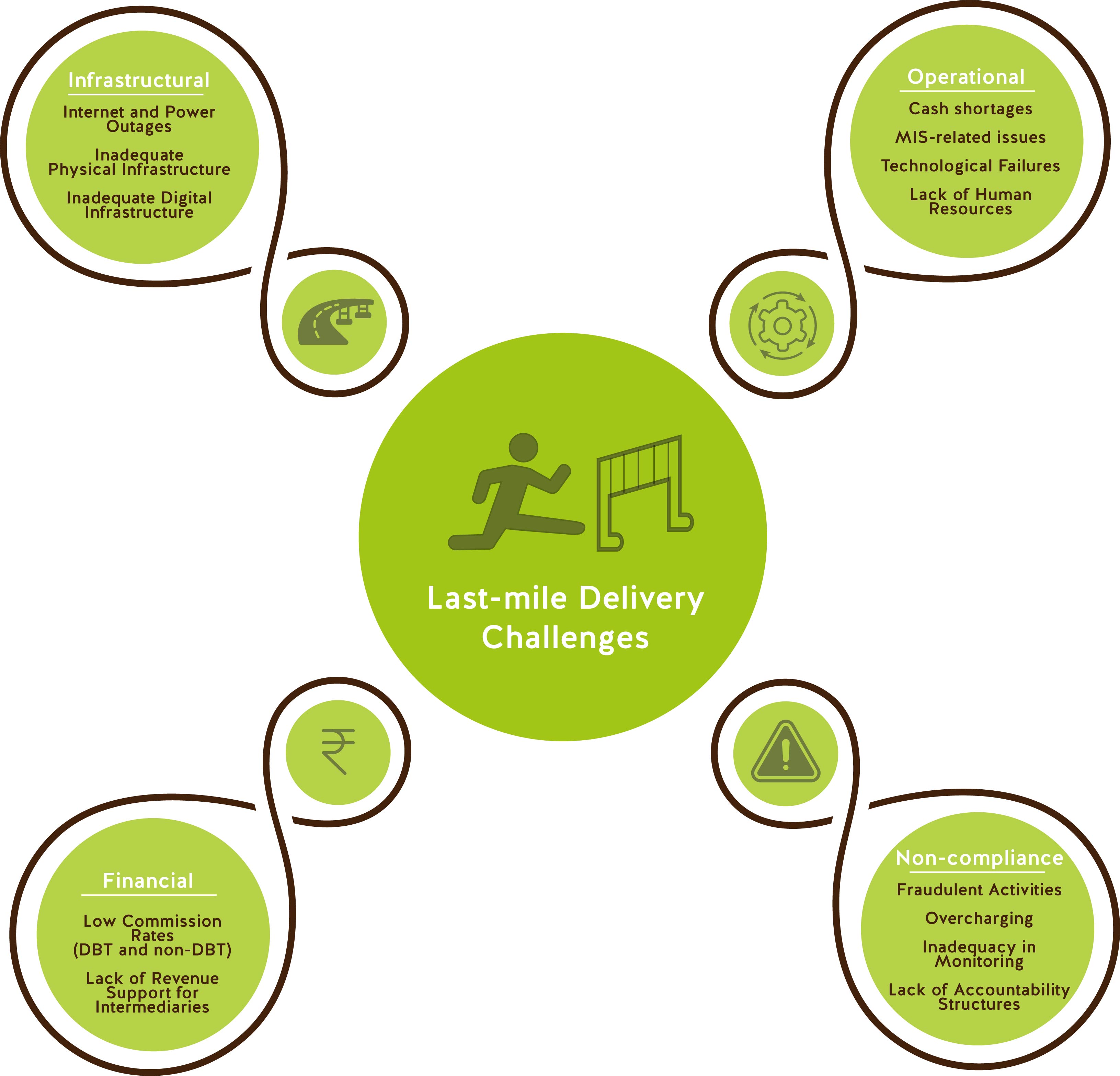The Delivery Dilemma
Designing social protection interventions is only one part of India’s welfare story, delivering the benefits promised in a time-and cost-efficient manner to the ‘targeted’ populace forms the rest. Reaching the ‘last-mile’ has invariably proven to be a conundrum that has vexed Indian policymakers since the very conception of our welfare State. The last decade or two have seen various innovative solutions come to the fore, with the baton being gradually passed from quintessential government officials to new-age ‘village-level entrepreneurs’[1]. Recent policy trends in last-mile delivery mechanisms signal an untempered euphoria regarding digitization of administrative machinery, biometric systems, and privately-run citizen interfaces.
The robustness of such delivery mechanisms goes beyond the sheer quantum of touch points available to the citizens. Strengthening last-mile delivery of social welfare benefits is not limited to putting in place infrastructural facilities but also entails building strong institutional arrangements, appropriate models of consumer-interface architecture, quality human resources, and a well-functioning grievance redressal system.
Focus on Exclusion
A crucial aspect of assessing last-mile delivery mechanisms is to identify the possible points of exclusion that fraught the supply chain of benefits from the government to the citizen. The design and implementation of welfare schemes must ensure minimization of exclusion errors as far as possible, where such an error is typically defined as the omission of eligible individuals or households. The existing literature[2] surrounding exclusion errors inordinately focuses on errors that arise due to inaccurate targeting methodologies adopted by implementing governments.
It leaves a lot to be desired when it comes to systematically expounding on exclusion errors emerging from factors unrelated to mere targeting methodologies. An end-to-end study of exclusion errors is imperative because if left unaddressed, these errors trickle into processes well beyond scheme targeting and emerge at various stages of scheme implementation.
In the Indian context, the emergent trend of digitization of procedures and channels for delivering government services mandates a closer look at the possible points of exclusion in the system. These errors assume even more significance when social security benefits are transferred in the form of cash via digitized mechanisms, especially in rural areas. More recently, there have been efforts in measuring exclusion errors, specifically for the ones caused by biometric mechanisms in beneficiary verification.
However, these studies are few in number and rely heavily on case studies and consequently, anecdotal evidence.
Direct Benefit Transfers in India
Contemporary policy discourse surrounding last-mile delivery of social welfare benefits in the country has revolved around a much-touted system of ‘Direct Benefit Transfers’ (DBT). In India, DBT has been part of a larger slew of policy initiatives, with the latter’s origin found in the National e-Governance Plan (NeGP) of 2006. The prominence of the DBT framework is reflected in the government’s continuous attempts to subsume all possible schemes under the DBT system, and in the process, digitize its administrative machinery to facilitate these new policy initiatives. As of January 2020, beneficiary payments from a total of 429 government schemes are being channelled through the DBT framework. These government schemes include Janani Suraksha Yojana (maternity benefit scheme), PM Kisan (cash transfers for small and marginalized farmer families), direct cash transfers for food grains, amongst others. The official website of DBT Mission (a project directly administered by Central government’s Cabinet Secretariat) provides illustrative statistics for the value and number of DBT transactions as well as the estimated gains (pegged at INR 51,664.85 crores) realized from “removal of duplicate/fake beneficiaries and plugging of leakages”.
The ‘directness’ in transfers is stated to be achieved by virtue of technological mediation (biometric verification of beneficiaries, online transfers of monetary benefits, and digitized data records) and elimination of rent-seeking middle-men typically intermediating between the citizen and State. DBT has been hailed as a policy tool which would reduce leakages in delivery and do away with ghost beneficiaries, thereby helping the exchequer save millions in administrative expenses. Inevitably, it has come to dominate the narrative around welfare delivery in the country.
Is Technological Mediation Enough?
However, a lot more sobering picture of DBT’s design and implementation is found outside the policy corridors. This discourse questions the claims made about the effectiveness of a DBT system in strengthening last-mile delivery and also of all the paraphernalia that comes with it. A 2014 paper titled, ‘Is There Such a Thing as a “Direct” Cash Transfer?’ uses a negative case study from Telangana to highlight the fallouts of the DBT system and argues that unless technological platforms are accompanied by other institutional mechanisms and political will, extant inefficiencies will continue to persist. In February 2018, a Pradhan Mantri Awas Yojana (PMAY) beneficiary was accused of theft after her biometrics got linked to her namesake’s account, in Simdega district, Jharkhand[3]. Far more serious incidents have also been reported by Right to Food activists in Jharkhand, who have listed 20 deaths between September 2017 and June 2019 due to hunger and malnutrition because of alleged irregularities in the Public Distribution System (PDS) and denial of social security pensions in some cases. The reasons for these irregularities vary. From the deletion of ration cards to issues related to linking ration cards with Aadhaar, the system has seemed to “create more problems than it solves, excluding many families rather than including them”.
Such instances indicate that even post-digitization, G2C services require high-quality procedures and controls including management oversight and continual monitoring, whether delivered by government/programme staff or when outsourced to one or more third-party (private or public) intermediaries. Research also reveals a cohort of problems that continue to debilitate delivery in the last-mile despite the DBT system. These include, but are not limited to, inadequate banking infrastructure to smoothly facilitate DBTs in rural areas, under-staffed access points, authentication failures, and connectivity (internet as well as electrical) problems. Moreover, one of the research studies[4], goes beyond DBT, and highlights why cash transfers in lieu of in-kind is itself a bad idea to start with.
Measuring the Scale of Exclusion in Welfare Transfers
Against this backdrop, we would like to initiate a comprehensive research inquiry into the delivery mechanisms currently in place for social protection in India. The focus of our research would be to identify and measure the scale of exclusion errors across the life-cycle of welfare transfers from the government to the citizen. The research study would entail a stock-taking exercise of last-mile delivery challenges faced by both citizens as well as delivery intermediaries. Figure 1 below provides a preview of the various last-mile delivery challenges currently present in the welfare delivery ecosystem, as documented through anecdotes and case studies.
Our aim is to capture these issues empirically and provide a holistic understanding of the issues in last-mile delivery of social protection, across regions and schemes in India.
Figure 1: Last-mile Delivery Challenges in Welfare Transfers

—
Carter, B., et al. (2019). Social Protection Topic Guide. Revised Edition. K4D Emerging Issues Report 18. Retrieved from Department for International Development, Government of UK: https://www.gov.uk/dfid-research-outputs/social-protection-topic-guide-2019
DBT Mission, Government of India. (2019). DBT Bharat. Retrieved from DBT Mission: https://dbtbharat.gov.in/estimatedgain
DBT Mission, Government of India. (2019). DBT Bharat. Retrieved from DBT Mission: https://dbtbharat.gov.in
Drèze, J. (2016, March 15). The Aadhaar Coup. Retrieved from The Hindu: https://www.thehindu.com/opinion/lead/jean-dreze-on-aadhaar-mass-surveillance-data-collection/article8352912.ece
Khera, R. (2019, March 09). India Needs Banks in Underserved Areas, Not Aadhaar, To Deliver Direct Benefit Transfers. Retrieved from IndiaSpend: https://www.indiaspend.com/india-needs-banks-in-underserved-areas-not-aadhaar-to-deliver-direct-benefit-transfers/
Ministry of Electronics & Information Technology, Government of India. (2018). National e-Governance Plan. Retrieved from Ministry of Electronics & Information Technology: https://meity.gov.in/divisions/national-e-governance-plan
Sabates-Wheeler, et al. (2014). Targeting Social Transfer Programmes: Comparing design and implementation errors across alternative mechanisms. Retrieved from United Nations University: https://www.wider.unu.edu/sites/default/files/wp2014-040.pdf
Singh, S. (2019, July 13). Death by digital exclusion? On faulty public distribution system in Jharkhand. Retrieved from The Hindu: https://www.thehindu.com/news/national/other-states/death-by-digital-exclusion/article28414768.ece
Srinivasan, V., et al. (2014). Is there such a thing as a “direct” cash transfer? Retrieved from Stanford CDDRL: https://cddrl.fsi.stanford.edu/publication/there-such-thing-direct-cash-transfer
[1] Private citizens operating Common Services Centres facilitating G2C and B2C services for citizens, envisaged as “entrepreneurs” fulfilling twin goals of social development and self-profitability. For more details, see CSC 2.0 Implementation Guidelines.
[2] See Coady, et al. (2004), Sabates-Wheeler, et al. (2014), Hanna and Karlan (2017), and Devereux, et al. (2017)
[3] See Pragya Kendra Assessment Study: Case Studies
[4] See Khera, R (2013)


